Introducción

En la era digital actual, pantallas de visualización LED have been widely used in various fields, but do you know that there are many hidden safety hazards behind these gorgeous screens? Temperature, humidity, power supply, operation…
Every link may become a “stumbling block” for safety. So, how to ensure the safety of LED display screens and avoid accidents? This article will answer them for you one by one.
Tabla de contenido
1. About the safety of the use environment of LED display screens

LED display screens are actually quite “delicate” and have requirements for temperature and humidity.
In terms of temperature, it can work normally in the range of -20℃ to 50℃, but this is only the limit range.
If it is used in a place that is too cold or too hot for a long time, the display screen may “get angry”, such as difficulty starting at low temperatures and easy to overheat protection at high temperatures.
The same is true for humidity. The relative humidity is best between 10% and 90%.
If it is too humid, the display screen is prone to “sweat,” causing short circuits or rusting of components; if it is too dry, static electricity will come to mess up.
Therefore, if your display is placed indoors, it is best to install an air conditioner or ventilation equipment to keep the temperature at around 20℃ to 30℃ for a comfortable temperature.
In terms of humidity, a dehumidifier can be used in humid places, and a humidifier or a few pots of green plants can be placed in dry places so that the display will be safer to use.
Things cannot be placed around the LED display, especially flammable objects and dust.
Flammable objects such as paper, wood, and cloth can easily catch fire once they touch the high-temperature components around the display.
The display itself will heat up when it is working. If there are flammable objects next to it, it will be dangerous.
Therefore, at least 1 meter of space should be left around the display, and flammable and explosive objects should not be placed.
Dust is also a troublesome thing. It will stick to the surface and inside of the display, affecting the heat dissipation and display effect, and may cause the circuit to short-circuit over time.
Therefore, it is necessary to “bathe” the display regularly and gently wipe the surface with a soft cloth.
If you want to clean the inside, it is best to find a professional; otherwise, it will be troublesome if you accidentally break it.
Waterproof and moisture-proof are very important for LED display screens. Water must not enter the screen body.
Once water enters, the circuit will be short-circuited, the components will be corroded, and the display screen will be “scrapped”.
If you find that the screen body has water in it, don’t panic; cut off the power supply immediately, put the display screen in a ventilated and dry place to dry, or use a hair dryer or other equipment to blow it dry.
Wait until it is completely dry before turning on the power. The outer shell of the display screen must have good sealing, and be careful not to let it come into contact with rain or water vapor during installation.
The waterproof performance of outdoor display screens is generally good, but it is still necessary to check the sealing strips regularly to see if they are aging or damaged.
If the drainage system is blocked, it is also dangerous for rainwater to accumulate around the display screen, so make sure that the drainage is unobstructed.
When installing LED display screens, lightning rods must be installed. Because the display screens are usually installed at high places or on the facades of buildings, they are easily struck by lightning.
The power of lightning strikes is very strong, which can instantly “break down” the electronic components in the display screen and even cause fires.
The function of the lightning rod is to lead lightning to the ground and protect the display screen.
You must find a professional to install the lightning rod, otherwise it will not work if it is not installed properly.
The grounding resistance of the lightning rod should be less than 4 ohms, and it should be connected to other grounding systems of the building.
In addition to the lightning rod, you can also install a lightning arrester on the power supply and signal line of the display screen, which can better prevent the “invasion” of lightning.
If you encounter thunderstorms, the safest way is to temporarily turn off the display screen, cut off the power supply and signal line, and wait for the thunderstorm to pass before using it.
2. About the power supply safety of the LED display screen

1). Connect the fuente de alimentación correctly
Pay special attention to the power connection of the LED display screen. Its module is powered by DC +5V, and must not use AC power, and the positive and negative poles cannot be connected in reverse.
If it is connected incorrectly, the equipment can easily be burned out, and it may even cause a fire, with disastrous consequences.
Therefore, when connecting the power supply, be sure to carefully check the positive and negative poles, connect them correctly according to the requirements of the manual, and ensure that the power supply is safe and reliable.
2). Voltage and frequency requirements
There are also strict requirements for the voltage and frequency of the power supply. The voltage should be 220V, with a floating range of ±10%, and the frequency should be 50Hz, with a floating range of ±5%.
At the same time, the grounding must be reliable, and the ground wire and the neutral wire must be strictly isolated and cannot be mixed together.
Poor grounding or indistinguishable ground wire and neutral wire may cause the display screen to malfunction and even affect the safety of the equipment.
Therefore, it is best to ask a professional electrician to check the power line to ensure that everything meets the requirements.
3). Avoid overload
When the LED display screen plays a high-brillo full-white picture, the current will be particularly large.
If it is played like this for a long time, the power cord will heat up, which will not only affect the service life of the display screen, but also may cause safety hazards.
Therefore, try to avoid playing the full-white picture for a long time or appropriately reduce the brightness of the picture so that the display screen can be “relaxed” a little, and it can also extend its service life.
4). Emergency treatment
If the display screen is found to have short circuit, tripping, burning wire, smoking and other abnormal phenomena during use, it must be stopped and the power supply cut off immediately.
Then, carefully find the cause of the fault to determine where the problem is. If you can’t do it yourself, don’t force it.
Find a professional maintenance person to handle it immediately. Ensure safety before continuing to use it.
3. About the operation safety of LED display

1). Switching screen sequence
When operating the LED display, the switching screen sequence is very important. When turning on the screen, turn on the control computer first, and then turn on the LED display after it is fully started and running normally.
When turning off the screen, the sequence is reversed. Turn off the power of the LED screen first, and then turn off the control software and computer.
The time interval between switching the screen on and off should be greater than 2 minutes so that the device has enough time to “buffer” to avoid equipment problems caused by too fast operation.
2). Avoid frequent switching
When using the LED display, try not to switch the power on and off frequently. There should be at least 1 minute between each switching operation.
Frequent switching of the power supply will cause an impact on the electronic components of the display, just like a person suddenly goes from a hot place to a cold place, and the body is easily unable to bear it.
The same is true for equipment. Frequent switching may shorten its service life or even cause failure.
3). Non-professionals are prohibited from operating
The internal circuit of the LED display is very complicated, like a mess, with many live parts inside.
Non-professionals should never touch it; otherwise, it is easy to get an electric shock or accidentally damage the equipment.
If maintenance or adjustment is required, be sure to find a professional technician to handle it. They know the “doorway” inside and can solve the problem safely.
4. Emergency management of LED display screens

1). Make an emergency plan
When using LED display screens, it is inevitable to encounter some emergencies, such as sudden power failure, accidental damage to the equipment, or natural disasters and other unexpected situations.
In order to deal with these situations, a detailed emergency plan must be made in advance. This plan should clearly state what everyone should do and who is responsible for what tasks once a problem occurs.
For example, who will check the power problem, who will contact the maintenance personnel, who will be responsible for evacuating the surrounding people, etc.
In this way, when encountering an emergency, everyone will know what to do and will not be in a mess.
2). Regular drills
It is not enough to have an emergency plan alone, but also to organize emergency drills regularly.
Just like the fire drills in schools, through drills, everyone can be familiar with the emergency process and improve their ability to deal with emergencies.
At the same time, drills can also enhance collaboration between teams so that everyone knows how to cooperate in an emergency.
After the drill, you can also summarize the experience and see if there are any areas that need to be improved in the plan to make the emergency plan more perfect.
3). Prepare emergency supplies
Emergency supplies are an important guarantee for dealing with emergencies. Make sure that emergency supplies such as first aid kits, toolboxes, and backup power supplies are ready at any time.
Some common first aid supplies such as Band-Aids and disinfectants can be placed in the first aid kit for use when someone is injured。
There should be some common maintenance tools in the tool box to facilitate maintenance personnel to quickly deal with problems.
The backup power supply can temporarily power the display screen when the main power fails to ensure that the equipment will not be damaged due to power outages.
These emergency supplies should be checked regularly to see if they are expired or damaged and updated and supplemented in time to ensure that they can be used at critical moments.
5. Conclusión
Through the introduction of this article, I believe you have a more comprehensive understanding of the safe use of LED display screens.
From environmental control to power supply guarantee, from operating specifications to emergency management, every link is crucial.
For the safety of yourself and others, and for the stable operation of the equipment, please pay attention to these details.
Finalmente, si quieres saber más sobre las pantallas LED, Por favor póngase en contacto con nosotros.
